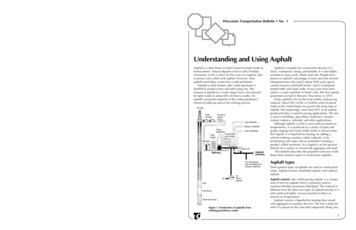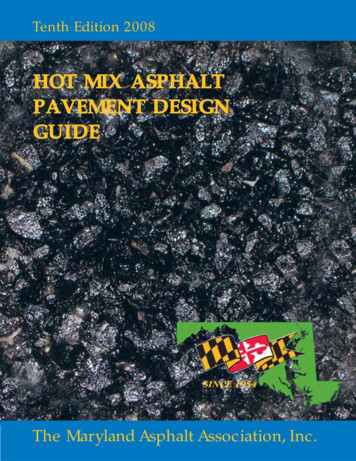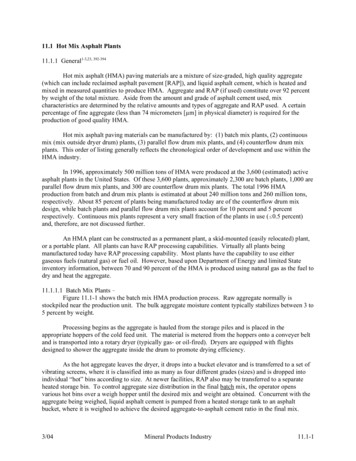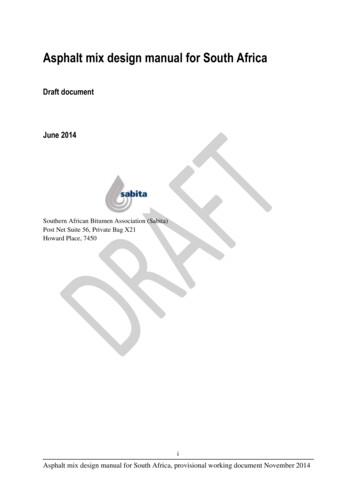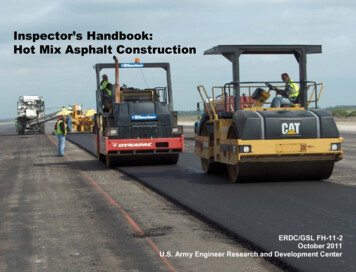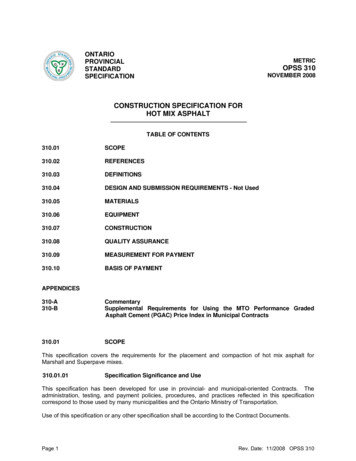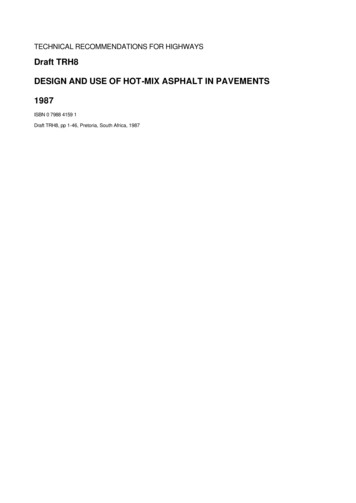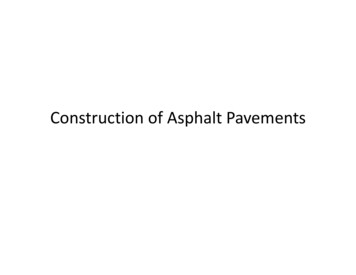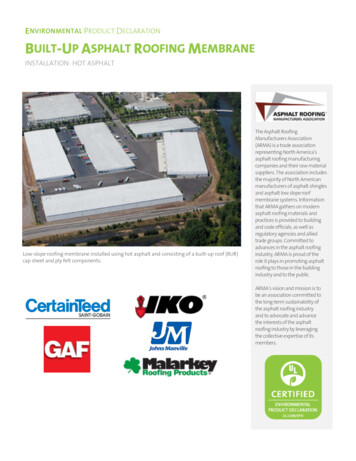
Transcription
ENVIRONMENTAL PRODUCT DECLARATIONBUILT-UP ASPHALT ROOFING MEMBRANEINSTALLATION: HOT ASPHALTLow-slope roofing membrane installed using hot asphalt and consisting of a built-up roof (BUR)cap sheet and ply felt components.The Asphalt RoofingManufacturers Association(ARMA) is a trade associationrepresenting North America’sasphalt roofing manufacturingcompanies and their raw materialsuppliers. The association includesthe majority of North Americanmanufacturers of asphalt shinglesand asphalt low slope roofmembrane systems. Informationthat ARMA gathers on modernasphalt roofing materials andpractices is provided to buildingand code officials, as well asregulatory agencies and alliedtrade groups. Committed toadvances in the asphalt roofingindustry, ARMA is proud of therole it plays in promoting asphaltroofing to those in the buildingindustry and to the public.ARMA’s vision and mission is tobe an association committed tothe long-term sustainability ofthe asphalt roofing industryand to advocate and advancethe interests of the asphaltroofing industry by leveragingthe collective expertise of itsmembers.
Page 3 of 13BUILT-UP ASPHALT ROOFING MEMBRANEINSTALLATION: HOT ASPHALTAccording to ISO 14025 and ISO 21930:2007This declaration is an environmental product declaration (EPD) in accordance with ISO 14025. EPDs relyon Life Cycle Assessment (LCA) to provide information on a number of environmental impacts of productsover their life cycle. Exclusions: EPDs do not indicate that any environmental or social performancebenchmarks are met, and there may be impacts that they do not encompass. LCAs do not typicallyaddress the site-specific environmental impacts of raw material extraction, nor are they meant to assess human healthtoxicity. EPDs can complement but cannot replace tools and certifications that are designed to address these impactsand/or set performance thresholds – e.g. Type 1 certifications, health assessments and declarations, environmentalimpact assessments, etc. Accuracy of Results: EPDs regularly rely on estimations of impacts, and the level ofaccuracy in estimation of effect differs for any particular product line and reported impact. Comparability: EPDs are notcomparative assertions and are either not comparable or have limited comparability when they cover different life cyclestages, are based on different product category rules or are missing relevant environmental impacts. EPDs fromdifferent programs may not be comparable.PROGRAM OPERATORDECLARATION HOLDERDECLARATION NUMBERUL EnvironmentAsphalt Roofing Manufacturers Association (ARMA)4787168709.103.1DECLARED PRODUCTBuilt-Up Asphalt Roofing Membrane (Installation: Hot Asphalt)REFERENCE PCRDATE OF ISSUEPERIOD OF VALIDITYASTM: Asphalt shingles, built-up and modified bituminous membrane roofing. 2014October 28, 20165 YearsProduct definition and information about building physicsCONTENTS OF THEDECLARATIONInformation about basic material and the material’s originDescription of the product’s manufactureIndication of product processingInformation about the in-use conditionsLife cycle assessment resultsTesting results and verificationsThe PCR review was conducted by:ASTM InternationalChair: Francois Charron-Doucetcert@astm.orgThis declaration was independently verified in accordance with ISO14025 by Underwriters Laboratories INTERNAL EXTERNALWade Stout, UL EnvironmentThis life cycle assessment was independently verified inaccordance with ISO 14044 and the reference PCR by:Thomas P. Gloria, Industrial Ecology ConsultantsThis EPD conforms with ISO 21930:2007
Page 4 of 13BUILT-UP ASPHALT ROOFING MEMBRANEINSTALLATION: HOT ASPHALTAccording to ISO 14025Participating MembersThe following ARMA members provided data for the product covered within this comIKOwww.iko.comJohns Manvillewww.jm.comMalarkey Roofingwww.malarkeyroofing.comProduct DefinitionProduct DescriptionThe low-slope roofing membrane included in this study consists of built-up roof (BUR) cap sheet and ply R Cap SheetASTM D3909; CSA A123.2- Mineral-surfaced BUR cap sheets consist of asphalt-impregnated andcoated glass felt roll roofing surfaced on the weather side with coloredmineral granulesBUR Ply FeltASTM D2178; CSA A123.17- Ply felts consist of glass felts impregnated with oxidized asphalt- A fine mineral matter parting agent is typically applied to facilitate useduring installationManufacturing LocationsThe components of the low-slope BUR roofing membrane are manufactured in the United States and/or Canada.Applications and UsesLow-slope roofing systems are installed on roofs with slopes less than 2:12. Low-slope roofing systems are primarilyused to protect buildings and structures from the weather.One significant benefit of BUR systems is the protection provided by the multiple water-resistant layers. Thesesystems are durable and can stand up to weather conditions, temperature extremes, impacts, and foot traffic. BURroofing systems can be installed in a variety of ways to meet many building design requirements.
Page 5 of 13BUILT-UP ASPHALT ROOFING MEMBRANEINSTALLATION: HOT ASPHALTAccording to ISO 14025System DescriptionMaterial ContentTable 1 shows the input materials for the BUR mineral-surfaced cap sheet and ply felt manufacturing, and the weightpercentages of the components in the product system. The remainder of the system weight consists primarily ofasphalt applied during installation.Table 1: Material inputs, average, for BUR cap and ply felt manufacturingMaterial Inputs*Weight Percentage inIndividual ComponentBUR Mineral Cap Sheet (39% of representative roofing system)Mineral granules26%Mineral stabilizers29%Asphalt34%Sand8%Fiberglass mat4%BUR Ply Felt (10% of representative roofing system)Asphalt71%Fiberglass mat27%Sand1%Release agent (soaps, sodium cocoate)1%*Total system also includes weight of ancillary materials used during installationManufacturing ProcessBUR Mineral-surfaced Cap SheetManufacture of mineral-surfaced cap sheets involves impregnating and coating a fiberglass mat with a filled asphaltcoating. The filled coating mixture is produced in a separate process that involves mixing oxidized asphalt andlimestone (or other suitable mineral stabilizer) in appropriate proportions. Colored mineral granules are added assurfacing. Fine mineral matter may be used as a parting agent. The product is cooled, wound into rolls, and packagedfor shipment.
Page 6 of 13BUILT-UP ASPHALT ROOFING MEMBRANEINSTALLATION: HOT ASPHALTAccording to ISO 14025Figure 1: Mineral-surfaced cap sheet process diagramBUR Ply FeltManufacture of ply felts involves impregnating a fiberglass mat with oxidized asphalt. A fine mineral matter partingagent is typically applied to facilitate installation. The product is cooled, wound into rolls, and packaged for shipment.Figure 2: Ply felt process diagramInstallationFor this EPD, a BUR membrane consists of three ply felts and a mineral-surfaced cap sheet. Hot-mopped BURinstallation requires hot asphalt to be mopped onto the roof surface and the ply felts unrolled directly into the asphaltand broomed into place. Asphalt kegs are heated in a propane-fueled kettle to the required temperature and viscosityfor their application. This process is repeated until three layers of ply felts have been installed. The same process isused to install the mineral-surfaced cap sheet on top of the three-ply layer of felts. Mineral granules are applied to theasphalt that has migrated out of the cap sheet seams to protect it from UV and for aesthetic reasons.
Page 7 of 13BUILT-UP ASPHALT ROOFING MEMBRANEINSTALLATION: HOT ASPHALTAccording to ISO 14025Figure 3: Built-Up roofing system installation detailThe table below presents the installation details for the membrane. The effective coverage includes the requiredoverlap of sheets while the scrap rate accounts for material wasted during installation. The VOC emissions from theasphalt kettle are calculated using the US Environmental Protection Agency (EPA) Area Source Category Method.Table 2: Roofing system installation inputs and outputs, per 1 m2Weight ofMaterial[kg / m2]Effective Coverage[m2 of Material /1 m2 of Roof]ScrapRateRequired Quantity of Material[kg / 1 m2]Inputs3.61.065%4.1Ply 9N/A5%5.13Mineral granules (at seams)0.08N/A-0.08Cap sheetPropaneDiesel (pump to roof)2VOCs from asphalt kettle35.0 (MJ)N/A-5.0 (MJ)0.001 (MJ)N/A-0.001 (MJ)0.02N/A-0.02OutputsInstalled System9.95Waste0.51 1.22kg / 1layerAssumes 4-story building 1 and 3.95 m story height 23 3.1 kg VOCs/metric tonne of asphalt212m2 perhttp://buildingsdatabook.eren.doe.gov/docs/xls external/technical reports/PNNL-20380.pdf
Page 8 of 13BUILT-UP ASPHALT ROOFING MEMBRANEINSTALLATION: HOT ASPHALTAccording to ISO 14025End-of-LifeAt the end-of-life, the low-slope membrane is removed by manual labor, often with roofing shovels. The debris iscollected and transported off-site via truck. The waste is brought to a landfill.Life Cycle Assessment – Product Systems and ModelingDeclared UnitThe declared unit of this study is 1 m2 (10.8 ft2) of the installed roofing membrane. The associated reference flow (thequantity of material required to fulfill the declared unit) is 9.95 kg/m2.Life Cycle System BoundariesThe life cycle study encompasses the cradle-to-gate production, construction, and end-of-life (EoL) stages of a lowslope, hot-mopped BUR roofing membrane, including raw material extraction and processing, product manufacturing,and installation, plus material disposal at EoL. Transportation between stages has been accounted for, including rawmaterial transport to the manufacturing facility, finished product transport to the construction site, and transport of theroof system at EoL to the landfill. Use, maintenance, repair, or replacement of the roof system over a building’s servicelife is not included in this evaluation. In addition, production, manufacture and construction of manufacturing equipmentand infrastructure; repair and maintenance of the production system; energy and water use related to companymanagement and sales; delivery vehicles and laboratory equipment; as well as maintenance and operation of supportequipment are all outside of the scope of the study.XB5C1C2C3C4DisposalXB4Waste entA4RepairA3End-of-Life StageMaintenanceA2Use StageUseA1TransportConstruction StageRaw materialssupplyProduct StageMNDMNDMNDMNDMNDXXXXMND module not declaredAssumptionsThe analysis uses the following assumptions: Mineral granules can be made in a variety of colors, which affects the composition of the required mineralgranule coating. White mineral granules were selected as a representative product for this study because thepigment used for white products, titanium dioxide, generally has a higher impact than other pigments;therefore, using white is a conservative assumption.
Page 9 of 13BUILT-UP ASPHALT ROOFING MEMBRANEINSTALLATION: HOT ASPHALTAccording to ISO 14025 Where a manufacturer was unable to calculate an average distance for the distribution of its final product fromits facility, it provided a best estimate. Due to lack of data availability some proxy background data were used, specifically in the context of thegeographical scope of the study.Cut-off CriteriaNo cut-off criteria were applied in this study. All reported data were incorporated and modeled using best available LCIdata.TransportationProduction-weighted averages for the transportation distances and modes of transport associated with eachparticipating company are included for the transport of the raw materials to production facilities and the transport of thefinished products to distribution centers. The transport of finished products from distribution center to the constructionsite and of waste from the construction site to landfill were each assumed to be 20 miles.Temporal, Technological, and Geographical CoverageTemporal: Primary data, collected from the participating ARMA member companies, is representative of the year2012.Technological: At least 75% of the production market is estimated to be represented within this study.Geographical: The geographic coverage represented by this study is the United States and Canada, though somemanufacturers source their raw materials from outside this region. Whenever US background data were not readilyavailable, European data or global data were used as proxies, depending on appropriateness and availability. Resultsare presented as production weighted averages for the US and Canada.Background DataThe LCA model was created using the GaBi ts Software system for life cycle engineering, developed by thinkstep AG(previously PE INTERNATIONAL). The GaBi 2013 database provides the LCI data for several of the raw and processmaterials obtained from the background system. Secondary data, information from relevant literature, are from a rangeof sources between 1977 (asphalt oxidation information) and 2013.Data QualityAs the relevant foreground data is primary data or modeled based on primary information sources of the owner of thetechnology, no better precision is reachable within this product. Seasonal variations and variations across differentmanufacturers were balanced out by using yearly averages and weighted averages. All primary data were collectedwith the same level of detail, while all background data were sourced from the GaBi 2013 databases. Allocation andother methodological choices were made consistently throughout the model.AllocationAs several products are often manufactured at the same plant, participating companies used mass allocation to reportdata since the environmental burden in the industrial process (energy consumption, emissions, etc.) is primarilygoverned by the mass throughput of each sub-process.All packaging waste generated during installation, as well as 40% of the wooden pallets used for shipping of products,
Page 10 of 13BUILT-UP ASPHALT ROOFING MEMBRANEINSTALLATION: HOT ASPHALTAccording to ISO 14025are assumed to be sent to landfill and the system credited with any avoided production of electricity generated from thecombustion of landfill gas.The impacts due to the use of any recycled materials during manufacturing come only from further processing requiredduring the recycling process. Where in-house recycling is used to create other products, co-product allocation by massis used and any additional processing steps required for use of the recovered materials are accounted for. It isconservatively assumed that all roofing materials disposed at EoL are sent to landfill. This will vary from job site to jobsite as some roofers may recycle metal components.Life Cycle Assessment – Results and AnalysisEnvironmental Product Declarations (EPDs) created under a different Product Category Rule (PCR) are notcomparable. Additionally, EPDs based on a declared unit shall not be used for comparisons between products,regardless of the EPDs using the same PCR.Use of Material ResourcesThe material resource consumption associated with the installed roofing membrane is presented below for theproduction, construction, and EoL stages. Water consumption values are negative due to waste sent to landfill at EoL.A landfill introduces blue water to the watershed because it collects rainwater during its lifetime that is eventuallyreleased back into the ground, therefore more blue water is coming out of the process than going in. Rainwater is notblue water and is therefore not included in the water consumption metric.Table 3: Resource use results for each life cycle stage, per 1 C4)TotalRenewable materialskg21.43.31.225.9Nonrenewable materialskg7.81.92.412.1Water consumptionL13.32.4-21.8-6.1Impact CategoryPrimary Energy by Life Cycle StageThe primary energy demand associated with the installed roofing membrane is presented below for the production,construction, and EoL stages. Results are given as higher heating value (HHV), per the PCR. Renewable energy isnegative for construction due to the credit given for reusing pallets.Table 4: Primary energy demand results for each life cycle stage, per 1 C4)TotalNonrenewable fossilMJ (HHV)1542757.9437Nonrenewable nuclearMJ (HHV)3.71.00.24.9Renewable (solar, wind, hydro, geo)MJ (HHV)3.8-0.050.34.0Renewable (biomass)MJ (HHV)Primary Energy2x10-111x10-55x10-121 x 10-5Life Cycle Impact AssessmentThe environmental impacts associated with the installed roofing membrane are presented below for the production,construction, and EoL stages.
Page 11 of 13BUILT-UP ASPHALT ROOFING MEMBRANEINSTALLATION: HOT ASPHALTAccording to ISO 14025Table 5: Life cycle impact category results, per 1 m2 (TRACI 1-C4)TotalGlobal warming potentialkg CO2-eq3.93.10.57.5Smog creation potentialkg O3-eq0.30.30.040.6Impact Categorykg SO2-eq0.020.020.0020.04kg N-eq0.0017 x 10-43 x 10 -40.002kg CFC-11 eq4 x 10-103 x 10-91 x 10-114 x 10-9Acidification potentialEutrophication potentialOzone depletion potentialWaste GenerationThe waste generation associated with the installed roofing membrane is presented below for the production,construction, and EoL stages.Table 6: Waste generation results, per 1 m2Impact oL(C1-C4)TotalNon hazardous waste generatedkg0.40.510.010.9Hazardous waste generatedkg0.0012 x 10-42 x 10-40.002Additional Environmental InformationReflective RoofsReflective roofs are defined as roofing products with high solar reflectance. Many in the construction industry define“cool roofs” as roofing products with high solar reflectance and high thermal emittance. Asphalt-based products havethe inherent property of having high emittance, regardless of their reflective properties. Asphaltic roof systems typicallyhave thermal emittance values greater than 0.80. Reflectance is a deliberate product characteristic, and varies basedon the surfacing used.There are reflective roof options available for virtually any roof and any building. Because of asphalt roofs’ longevity,asphalt-based products provide excellent value for homeowners and building owners by delivering superior durabilityand sustainability at reasonable cost.BUR membranes provide options for varying levels of reflectivity. The reflectivity is related to color of the cap sheetsurface, surfacing material, or field applied coating. While reflective roofs are an increasingly popular roof option, theyrepresent one of many approaches to help building owners and consumers reduce building energy use and addresscontemporary environmental concerns.Individual Component ResultsThe material resource consumption, primary energy demand, environmental impacts, and waste generation resultsassociated with each individual component (excluding ancillary materials used during installation) of the roofing systemare presented below for the production stage (A1-A3).
Page 12 of 13BUILT-UP ASPHALT ROOFING MEMBRANEINSTALLATION: HOT ASPHALTAccording to ISO 14025Table 7: Production stage (A1-A3) impact results for each system component, per 1 m2 of individual componentImpact CategoryUnitsPly FeltMineral Cap sheetRenewable materialskg3.38.9Nonrenewable materialskg0.65.2Water consumptionL1.67.2Nonrenewable fossilMJ (HHV)18.583.8Nonrenewable nuclearMJ (HHV)0.51.8Renewable (solar, wind, hydro, geo)MJ (HHV)0.51.8Renewable (biomass)MJ (HHV)Global warming potentialkg CO2-eqSmog creation potentialAcidification potentialEutrophication potentialOzone depletion potential8 x kg N-eqkg CFC-11 eq10-42x6 x 10-46 x 10-112 x 10-10Non hazardous waste generatedkg0.040.2Hazardous waste generatedkg1 x 10-48 x 10-4References ASTM (2014). “Product category rules for preparing an environmental product declaration for product group:Asphalt Shingles, Built-up Asphalt Membrane Roofing and Modified Bituminous Membrane /152.PCR ASTM Asphalt Roofing PCR 073114.pdf) LBP, University of Stuttgart and thinkstep GmbH, Leinfelden-Echterdingen (2013). GaBi 6 datasetdocumentation for the software-system and databases (http://documentation.gabi-software.com/) thinkstep (formerly PE INTERNATIONAL) (2015). “Life Cycle Assessment of Asphalt Roofing Systems:Cradle-to-grave LCAs of a steep-slope and four low-slope industry-average asphalt roofing systems.” US EPA. “Area Source Category Method Abstract – Asphalt Roofing Kettles.” /2015-08/documents/asphalt.pdf)LCA DevelopmentThe EPD and background LCA were prepared by thinkstep, Inc.(previously PE INTERNATIONAL).thinkstep, Inc.170 Milk Street, 3rd FloorBoston, MA 02109info@thinkstep.comwww.thinkstep.com
Page 13 of 13BUILT-UP ASPHALT ROOFING MEMBRANEINSTALLATION: HOT ASPHALTAccording to ISO 14025Contact InformationAsphalt Roofing Manufacturers Association529 14th Street, NWSuite 750Washington, DC 20045Tel: (202) 591-2450
DECLARATION HOLDER Asphalt Roofing Manufacturers Association (ARMA) DECLARATION NUMBER 4787168709.103.1 DECLARED PRODUCT Built-Up Asphalt Roofing Membrane (Installation: Hot Asphalt) REFERENCE PCR ASTM: Asphalt shingles, built-up and modified bituminous membrane roofing. 2014 DATE OF ISSUE October 28, 2016 PERIOD OF VALIDITY 5 Years

